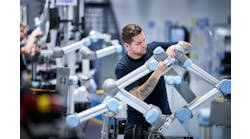If manufacturers have learned anything during the last several years, it is that the stakes of doing business have been permanently raised.
Prior to 2020, the manufacturing environment was characterized by a focus on quality, cost competitiveness, worker safety and protecting the environment. Over the last couple of years, manufacturers have faced additional imperatives – including how best to operate amid COVID-19, severe labor shortages, supply chain disruptions, steep inflation and geopolitical instability.
During this time of turbulence, emerging technology has ushered in what is commonly referred to as Industry 4.0 or the Fourth Industrial Revolution. This technology – which includes mobile devices, augmented reality, data analytics and artificial intelligence – is rapidly transforming the way manufacturers do business.
Combined, these trends present an unprecedented opportunity for manufacturers in America.
Today, the major question is not if a manufacturer will adopt automation and advanced technologies, but rather when and how. Adoption of Industry 4.0 technologies is a matter of survival – not only for large manufacturing companies, but also for small and mid-sized manufacturers.The long-term viability of these businesses likely depends on their ability to increase productivity while reducing costs.
Of the new Industry 4.0 applications being deployed in manufacturing operations, applied robotics have experienced the most growth. But more often than not, first-time adopters are apprehensive for fear of making an expensive mistake. According to the Manufacturing Institute, 1 in 3 manufacturers report that insufficient resources and expertise could limit their investment in emerging technologies.
Many myths continue to deter U.S. manufacturers from purchasing next-generation technology that would enhance their competitiveness. These myths include:
- Industry 4.0 systems are expensive and difficult to justify.
- These systems are only for large manufacturers that have high-quantity production.
- It takes a highly trained and well-compensated employee to program or operate a system.
The reality is that the actual cost of this emerging manufacturing technology has dropped by 25% to 50% in recent years, while software capabilities, speed and flexibility have been significantly enhanced.
Manufacturers that have adopted Industry 4.0 technology have discovered it is unnecessary to dedicate a flexible robot to a single task. Moreover, programming a robot has become simpler; workers can learn to program a robot in two or three days, thanks to intuitive interactive screens.
Having confronted and resolved these myths, the next step is to evaluate the benefits versus the actual costs. It cannot be stressed enough that this process is most effective if executed in conjunction with reputable and independent resources.
In Ohio, where I am based, The Ohio Manufacturers’ Association (OMA) has created an “Automation and Robotics Toolkit” to help manufacturers and regional leaders boost the competitiveness of the state’s leading industry. This toolkit also provides sample career pathways, while also identifying education and training programs throughout Ohio.
Manufacturers across the nation would be wise to study and emulate the OMA’s model, as well as Ohio’s network of local, manufacturer-led industry sector partnerships, which are helping manufacturers of all sizes unlock the potential of next-generation robotics and automation technology.
Robotics and automation technologies are enhancing the key operations of manufacturing at a lower cost, with more flexibility, and with greater ease of implementation than most of us could have imagined just a few years ago. While the stakes in manufacturing are higher than ever, so are the opportunities.
Geoff Lipnevicius is Lincoln Electric’s senior manager for workforce development. He serves as the chair of The Ohio Manufacturers’ Association’s Workforce Leadership Committee.




